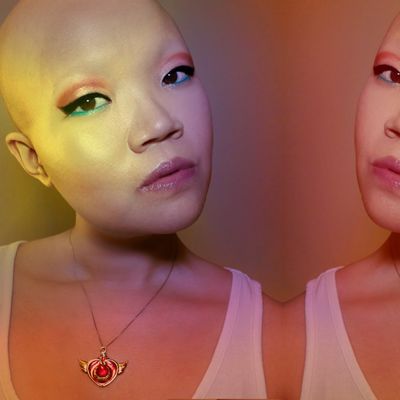
Letting go of all my hair had been looming step that had always terrified me, as if it would mean I would grow up incomplete or separate of my femininity.
It was August 2008 and I was sitting in the backroom salon chair of Peggy Tom’s San Francisco offices. This was my eighth visit to Miss Peggy in seven years and my fourth wig from her. But this would be my first time going completely bald. I closed my eyes as the razor began to buzz.
“Are you ready?” she asked. There would be no turning back once the blades touched my scalp.
When I first began losing my hair at 7 years old to alopecia, I jealously guarded any strands that remained on my head, reluctant to say good-bye as I watched fistfuls of hair detach themselves from my scalp. Without eyebrows or eyelashes or the long silky hair that Asian-American women seemed celebrated for, I constantly wondered whether I could ever be described as “normal” or even, dare I hoped, “beautiful.”
But I decided the answer would always be “no” after a playground bully pulled the bandanna that hid my hair loss off my head and the P.E. teacher who, without asking, told me to sit out of class because I “probably wouldn’t be comfortable sweating.” The taunts and snickers layered themselves over my self-esteem until any form of confidence disappeared.
By the time I was 11, nearly 75 percent of my hair was gone. The following year, after years of failed (and expensive) remedies and one too many in-classroom warnings about bandannas violating dress code, I got my first wig from Miss Peggy.
It felt as if alopecia had won a battle I didn’t know I was supposed to fight (to this day, there is still no cure for the autoimmune disease). Throughout middle school, I would flip through teen magazines and wander up and down the beauty aisles at Target, wishing I knew how to use the products that gave the CoverGirl models their smiles. In high school, I tried to copy the way my sister wore her eyeliner, hoping that makeup would “fix” me. I was trying to use makeup and products to do what a wig couldn’t — somehow make me feel beautiful and normal — because wig after wig, I still felt incomplete.
In 2008, at the age of 19, I forced myself to accept what I could not change. In less than five minutes, Miss Peggy’s razor touched my scalp and then the remaining hairs I had refused to let go of for years fell to the floor. I was ready to feel a weight lifted off my shoulders. I wanted to feel like the choice to be bald would be a moment of empowerment and enlightenment. I wanted to feel like I would gain something from all of this.
When the razor turned off, I stared at my reflection for what felt like an eternity. She fitted my wig, I left, and suddenly I felt the obvious that I couldn’t understand until I physically saw myself in that moment: I didn’t feel any different. I was still me, with all of my insecurities and imperfections — no matter how much hair I did or didn’t have on my head.
And somehow, by not feeling as if all of my problems were solved, I was changed because I realized I had been waiting for permission to feel “normal” or “beautiful.” I was waiting for something big to happen to validate the way I looked because — with every shampoo commercial I saw, with every YouTube video I watched on how important eyebrows were to a face, with every dramatic tear shed on America’s Next Top Model about hair makeovers — I didn’t think I was allowed to like being bald, let alone be okay with it, at all. As cheesy as it sounds, that decision had to come from within myself. I was always trying to seek validation from others who looked like me in order to feel okay, but because there weren’t really representations of others with alopecia, I was constantly insecure. The lesson I’ve figured out from going completely bald was realizing that no matter how much hair I had on my head, that wasn’t going to change how I felt. That confidence had to come from within.
It’s been a decade now since I last saw any hair growing from my head. Thanks to platforms like YouTube and Instagram, in the last ten years I’ve started to see more representations of people who look like me — bald, eyebrow-less, sad about missing ponytails, and still unsure of gluing false lashes to my eyelids — and who are out there challenging every beauty standard that says there’s only one “right” way to look.
Now, my choices to look how I want to look are not because I’m trying to hide anymore. When I try out a new wig or put makeup on now, it’s because I enjoy the art of it and, frankly, because I want to. I may not have won the battle against my immune system, but for the first time since I began losing my hair, I know I’m winning a more important fight.




